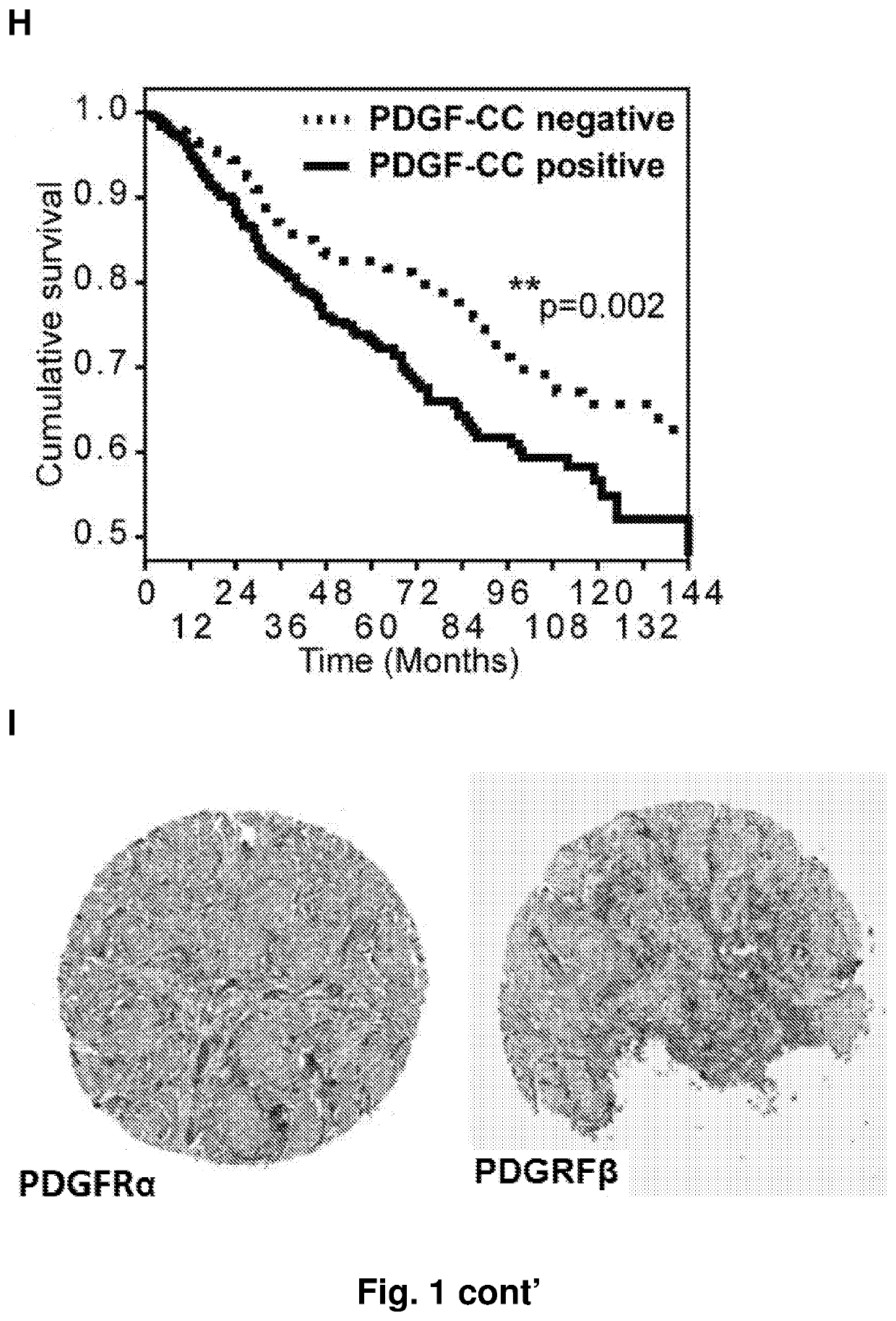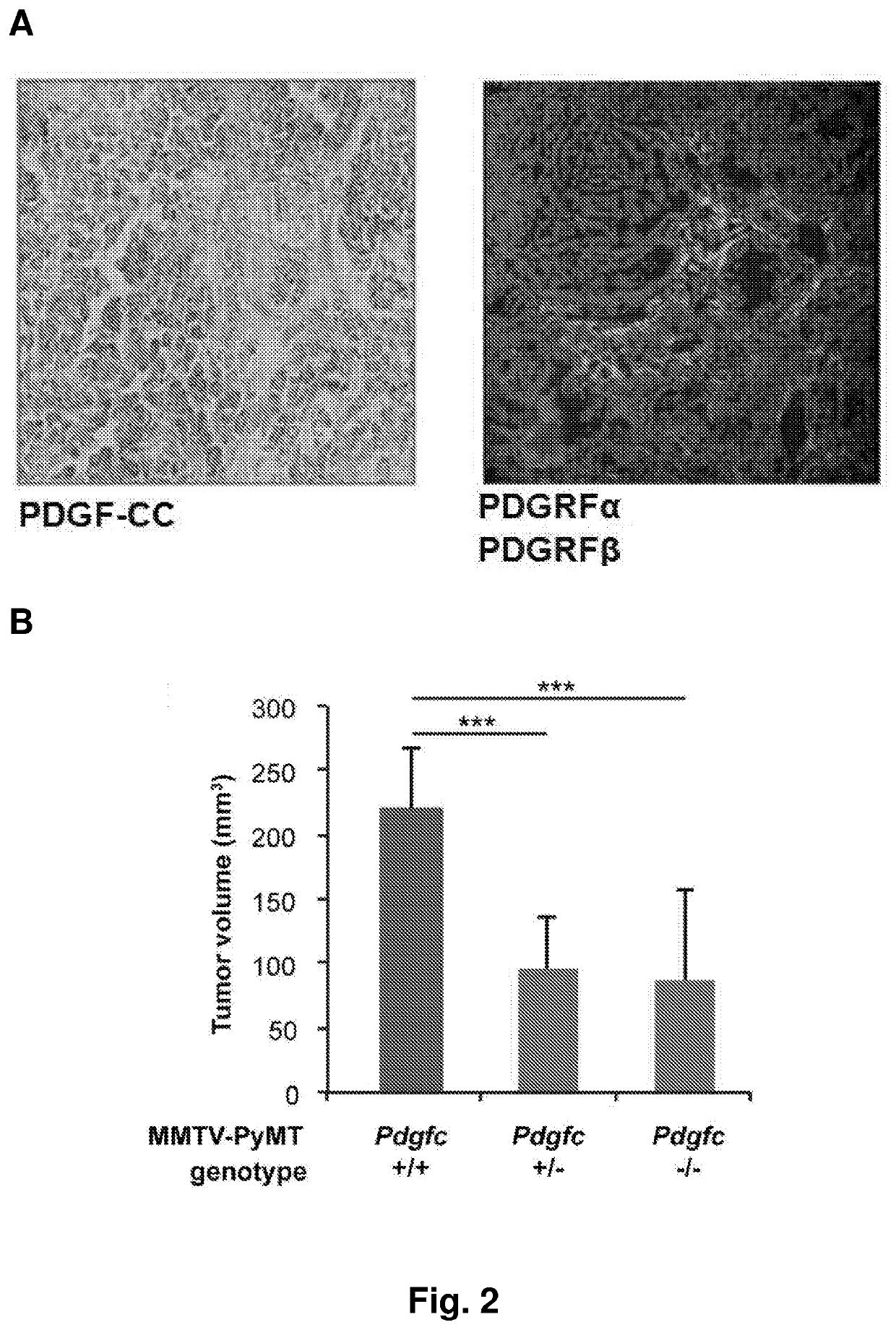Treatment of er-negative breast cancer with an pdgf-cc inhibitor and Anti-estrogen
a technology pdgf-cc, applied in the field of cancer treatment, can solve the problems of er-negative breast cancer that is accompanied by severe side effects, endocrine therapy which is associated with mild side effects compared to high-dose chemotherapy, and adjuvant treatment with anti-estrogens is not effective in treating triple-negative breast cancer
- Summary
- Abstract
- Description
- Claims
- Application Information
AI Technical Summary
Benefits of technology
Problems solved by technology
Method used
Image
Examples
example 1
-CC Antibody Sensitizes Tumor to Estrogen Therapy
Patent Cohort and the Definition of Breast Tumor Subtypes
[0308]Tissues from 890 patients with primary invasive breast cancer, diagnosed at the Institute of Surgical Pathology, USZ, between 1965 and 2004 (median July 1999), were analyzed. All patients enrolled voluntarily under Institutional Review Board-approved protocols and sample donors gave written informed consent. The ethics committee SPUK surgical-anesthetic-pathology at university hospital of Zrich, Switzerland, approved this study with reference number-StV 12-2005. For all these patients follow up data from the cantonal cancer registry were available; patients without follow up information were not considered (Theurillat et al, Int J Cancer, 2007). Additionally, 69 normal tissues and 152 in situ lesions (DCIS, LN) were analyzed. Molecular cancer subtypes were defined from detected ER, HER2 and CK5 / 6 by IHC. Luminal type: ER-positive cases, that were HER2-negative; HER2-type: ...
example 2
-CC and Aromatase Inhibitor
[0340]For therapeutic studies, 2×106 Human MDA-MB-231 cells were inoculated orthotopically in the 4th mammary fat pad in SCID mice. Tumor growth was monitored and measured once a week with a caliper in live sedated animals. Mice had been randomly assigned before tumor inoculation to receive treatment with anti-PDGF-C (mouse monoclonal antibody clone A3B6) antibody or IgG2a isotype control antibody (Bio X Cell), which were delivered via i.p. injection twice a week (300 μg per week) starting from the day of tumor establishment. For therapeutic trials involving endocrine therapy, when a tumor was palpable (longest diameter >3 mm), mice were alternately assigned into the treatment groups in which mice were treated with letrozole (1 mg / dose via oral gavage daily, Sigma), dissolved in a vehicle of ethanol and corn oil (Sigma) by heating to 55° C., or with vehicle alone. All therapeutic administrations were open-label.
[0341]The A3B6+letrozole group is statistical...
example 3
hibitor and Estrogen Antagonist
[0343]For therapeutic studies, 2×106 Human MDA-MB-231 cells were inoculated orthotopically in the 4th mammary fat pad in SCID mice. Tumor growth was monitored and measured once a week with a caliper in live sedated animals. Mice had been randomly assigned before tumor inoculation to receive treatment with the PFGF-R inhibitor imatinib or to placebo, which were delivered via i.p. injection twice a week (300 μg per week) starting from the day of tumor establishment. For therapeutic trials involving endocrine therapy, when a tumor was palpable (longest diameter >3 mm), mice were alternately assigned into the treatment groups in which mice were treated with tamoxifen (1 mg / dose via oral gavage daily, Sigma), dissolved in a vehicle of ethanol and corn oil (Sigma) by heating to 55° C., or with vehicle alone. All therapeutic administrations were open-label.
[0344]The imatinib+tamoxifen group is statistically significantly smaller than all other groups (p<0.01 ...
PUM
 Login to View More
Login to View More Abstract
Description
Claims
Application Information
 Login to View More
Login to View More - R&D
- Intellectual Property
- Life Sciences
- Materials
- Tech Scout
- Unparalleled Data Quality
- Higher Quality Content
- 60% Fewer Hallucinations
Browse by: Latest US Patents, China's latest patents, Technical Efficacy Thesaurus, Application Domain, Technology Topic, Popular Technical Reports.
© 2025 PatSnap. All rights reserved.Legal|Privacy policy|Modern Slavery Act Transparency Statement|Sitemap|About US| Contact US: help@patsnap.com



